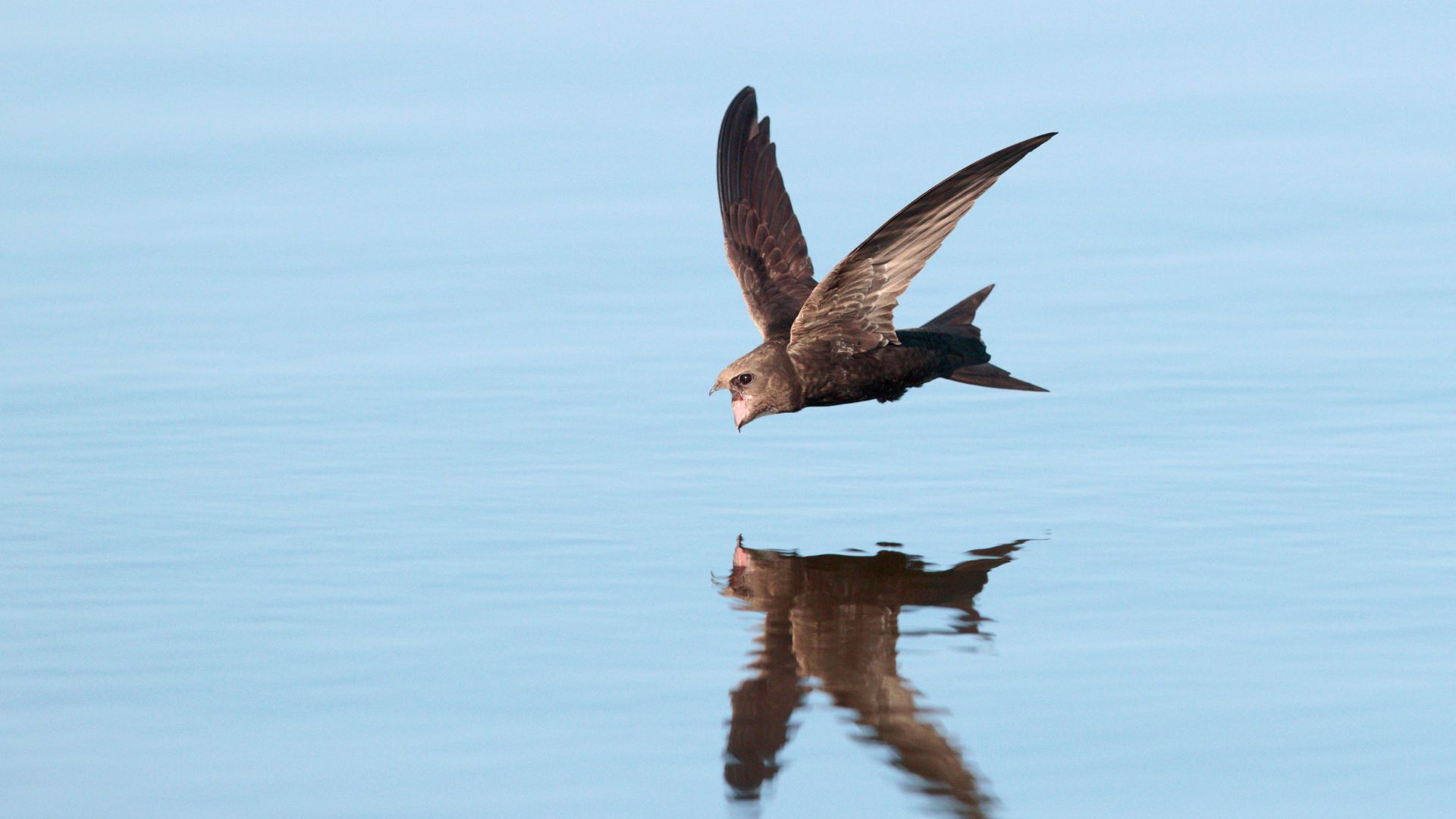For those residents of Scotland lucky enough to live near a population of visiting summer swifts, this bird’s screeching cries – for which they are known as ‘devil birds’ – will be as essential to summer evenings as long daylight hours and midges.
Apus apus – the much-loved Common Swift we find in Britain – has a cousin, Apus apus pekinensis, that breeds in Asia. These Swifts were first known to breed in Beijing when the original city walls were constructed in the 1400s1. The eaves and beams found in medieval Beijing provided the pekinensis Swift with nesting sites so ideal that the fortunes of this species seem to almost rise and fall with the construction or loss of man-made structures. The Swift, yuyan, shares its name with an archaic name for Beijing used in the Warring States period, Yanjing2. Swifts are also thought to be the inspiration for mythical birds that feature in Shang, Song and Ming Dynasty mythology3.
The real bird is perhaps no less otherworldly than its mythological counterpart. Their boomerang wings provide them with exceptional aerobatic skills, allowing them to catch up to 7,000 insects per day4. Most remarkable of all, they eat, mate and even sleep in the air, only landing to build nests and raise young. How they achieve sleep is still debated. Perhaps they shut down one side then the other hemisphere of their brain, alternately resting each half, or they fly up to a high altitude and then rest as they slowly glide downwards5. Pekinensis Swifts arrive in Beijing in April and will depart in the late summer after their chicks have fledged.
European Swifts are known to migrate to sub-Saharan Africa during the winter months, but the migration routes followed by Pekinensis Swifts were, until recently, a mystery. Between 2014 and 2018, a team of scientists and volunteers worked to closely monitor the migrations of the Swifts that nest on the Summer Palace in Beijing6. Using mist nets – gossamer-fine webs employed to catch birds for ringing – a handful of Swifts were fitted with geolocators in 2014 that would track their movements over the following year, until they returned, as most Swifts do, to the same breeding grounds from which they themselves had fledged.
Light-level geolocators were fitted to the Swifts with small harnesses, weighing only about 2% of the birds’ bodyweight7. These devices record the times of noon, dawn and dusk during the Swift’s journey, and from this, successive locations along their migration path can be calculated.
Researchers and volunteers were able to announce that the Pekinensis Swifts nesting on the Summer Palace fly every year to wintering grounds in south-western Africa. Of much interest to the scientists involved is that the birds were discovered to follow arid lands throughout most of their migration, seeming to favour conditions much drier than their Scottish cousins8.
After leaving Beijing, the Swifts travelled west and into Mongolia, before heading south again to Xinjiang, in western China. They then flew through central Asia before crossing the Red Sea and arriving in north-east Africa. After heading south, their journey ended in the Southern African Plateau, where they spent the winter before returning to Beijing in the spring9. It is believed that this entire journey is made without the Swifts once touching the ground.
Tragically yet unsurprisingly, Swifts are steadily becoming a rare sight in our skies. Reasons for their declining numbers include loss of suitable nesting sites, altered weather patterns which affect their migrations, and their insect prey becoming scarcer.
Their plight is increasingly recognised, however, which provides hope that further resources will be invested in their conservation. There is surely nothing more important than encouraging greater appreciation amongst the public for these birds, and for others like them that are threatened. Birdwatching is a growing interest in China, a hobby which is thought to have attracted 200,000 new enthusiasts between 2018 and 202310. And it’s not just pensioners: posts about ‘birdwatching equipment’ on Xiaohongshu, a social media site similar to Instagram, have spiked over the last few years11.
The fate of the Beijing Swift is dependent on the choices that we make today. The screaming swarms of Swifts that haunt the skies of summertime Beijing can be traced through the history of the city. We must work harder to ensure that both Scotland and China will continue to welcome this most captivating and enigmatic bird for years to come.
- Wild Beijing. 2015. “Out of Africa! The Beijing Swift’s Incredible Journey Charted at Last.” https://wildbeijing.org/the-beijing-swift-project/. ↩︎
- Common Swift. 2009. “Caring for the Common Swift in Beijing: Saving more than Swifts!” http://www.commonswift.org/4764Yuan.html. ↩︎
- Common Swift. 2009. “Caring for the Common Swift in Beijing: Saving more than Swifts!” http://www.commonswift.org/4764Yuan.html. ↩︎
- Xing Fangyu. 2019. “Welcome home, Beijing swifts.” CGTN, April 13. https://news.cgtn.com/news/3d3d674d7741444d34457a6333566d54/index.html ↩︎
- Coghlan, Andy. 2016. “Swifts break record by staying aloft for 10 months at a time.” New Scientist, October 27
https://www.newscientist.com/article/2110650-swifts-break-record-by-staying-aloft-for-10-months-at-a-time/ ↩︎ - Zhao, Y., Zhao, X., Wu, L., Mu, T., Yu, F., Kearsley, L., Liang, X., Fu, J., Hou, X., Peng, P., Li, X., Zhang, T., Yan, S., Newell, D., Hewson, C. M., Townshend, T., Åkesson, S., and Liu, Y. 2022. “A 30,000-km journey by Apus apus pekinensis tracks arid lands between northern China and south-western Africa.” Movement Ecology 10: https://doi.org/10.1186/s40462-022-00329-2 ↩︎
- Zhao, Y., Zhao, X., Wu, L., Mu, T., Yu, F., Kearsley, L., Liang, X., Fu, J., Hou, X., Peng, P., Li, X., Zhang, T., Yan, S., Newell, D., Hewson, C. M., Townshend, T., Åkesson, S., and Liu, Y. 2022. “A 30,000-km journey by Apus apus pekinensis tracks arid lands between northern China and south-western Africa.” Movement Ecology 10: https://doi.org/10.1186/s40462-022-00329-2 ↩︎
- Zhao, Y., Zhao, X., Wu, L., Mu, T., Yu, F., Kearsley, L., Liang, X., Fu, J., Hou, X., Peng, P., Li, X., Zhang, T., Yan, S., Newell, D., Hewson, C. M., Townshend, T., Åkesson, S., and Liu, Y. 2022. “A 30,000-km journey by Apus apus pekinensis tracks arid lands between northern China and south-western Africa.” Movement Ecology 10: https://doi.org/10.1186/s40462-022-00329-2 ↩︎
- Zhao, Y., Zhao, X., Wu, L., Mu, T., Yu, F., Kearsley, L., Liang, X., Fu, J., Hou, X., Peng, P., Li, X., Zhang, T., Yan, S., Newell, D., Hewson, C. M., Townshend, T., Åkesson, S., and Liu, Y. 2022. “A 30,000-km journey by Apus apus pekinensis tracks arid lands between northern China and south-western Africa.” Movement Ecology 10: https://doi.org/10.1186/s40462-022-00329-2 ↩︎
- Yi Shen. N.d. “Birdwatching Takes Flight in China.” China Minutes. https://chinaminutes.com/2025/04/23/birdwatching-takes-flight-in-china/ ↩︎
- Yi Shen. N.d. “Birdwatching Takes Flight in China.” China Minutes. https://chinaminutes.com/2025/04/23/birdwatching-takes-flight-in-china/ ↩︎
Iris Diggle is an undergraduate at the University of Edinburgh who is studying for a degree in Chinese. She will spend the 2025-26 academic year studying at Peking University in China. As well as having a keen interest in Chinese history and current affairs, she is an enthusiastic birdwatcher and is a Youth Representative for the British Trust for Ornithology. She expects to graduate from University in 2027.
- This author does not have any more posts.







